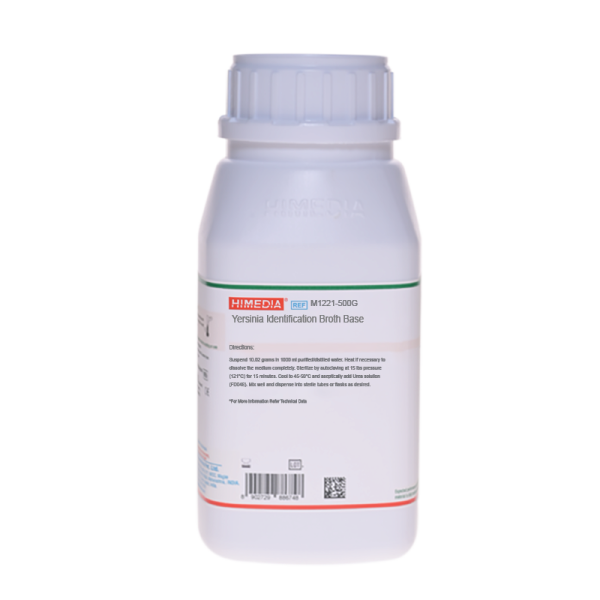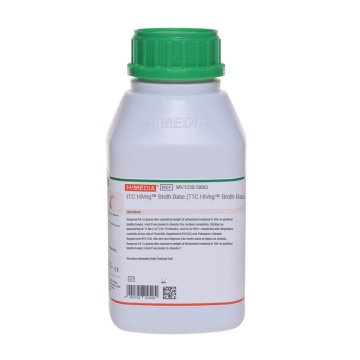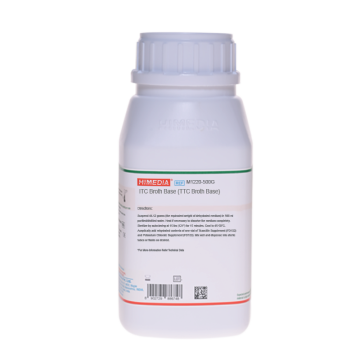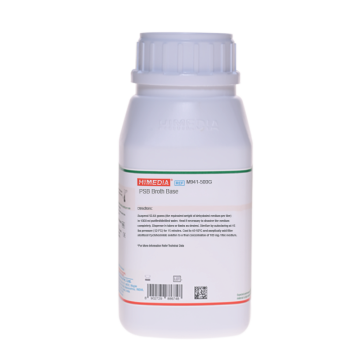 Your enquiry has been submitted
Your enquiry has been submitted
Yersinia Identification Broth Base
Yersinia#CC293D
Yersinia Identification Broth Base M1221
Intended use
Yersinia Identification Broth Base with addition of Urea is recommended for identification of Yersinia.
Composition**
| Ingredients | Gms / Litre |
|---|---|
| L-Tryptophan | 3.000 |
| Potassium dihydrogen phosphate | 1.000 |
| Dipotassium hydrogen phosphate | 1.000 |
| Sodium chloride | 5.000 |
| Phenol red | 0.025 |
Final pH (at 25°C): 6.9±0.2
**Formula adjusted, standardized to suit performance parameters
Directions
Suspend 10.02 grams in 1000 ml purified / distilled water. Heat if necessary to dissolve the medium completely. Sterilize by autoclaving at 15 lbs pressure (121°C) for 15 minutes. Cool to 45-50°C and aseptically add Urea solution (FD048). Mix well and dispense in sterile tubes or flasks as desired.
Principle And Interpretation
There are three species of Yersinia with unquestionable pathogenicity for humans Yersinia pestis, Yersinia psuedotuberculosis and Yersinia enterocolitica. Among these, Y.enterocolitica is usually associated with foodborne gastroenteritis. It is the most common species of Yersinia recovered from clinical specimens. The portal of entry in humans is the oral digestive route, with infection occurring in the terminal ileum (6). Yersinia Identification Broth Base is recommended for the identification of Yersinia from food and animal feeds by the ISO Committee (3).
L-Tryptophan serves as a base to test indole reaction. Phosphates buffer the medium while sodium chloride maintains the osmotic equilibrium of the medium. Phenol red is the pH indicator dye. Urea (FD048) is broken down by enzyme urease to yield ammonia. Ammonia increases the pH of the medium towards alkalinity, consequently making the phenol red indicator dye to change from an orange-red to a pink-violet colour.
Inoculate the test sample in PSB Broth (M941) and ITC Broth (M1220) for enrichment. After incubation at 25°C for 2-3 days, inoculate onto Yersinia Selective Agar Base (M843). Presumptive Yersinia colonies are confirmed biochemically by inoculating into Yersinia Identification Broth Base (M1221) (3).
Type of specimen
Animal feed and feeding stuff
Specimen Collection and Handling:
For food and dairy samples, follow appropriate techniques for sample collection and processing as per guidelines (2,5,6).
After use, contaminated materials must be sterilized by autoclaving before discarding.
Warning and Precautions :
Read the label before opening the container. Wear protective gloves/protective clothing/eye protection/ face protection. Follow good microbiological lab practices while handling specimens and culture. Standard precautions as per established guidelines should be followed while handling specimens. Safety guidelines may be referred in individual safety data sheets.
Limitations :
- Further isolation and biochemical tests must be carried out for confirmation
Performance and Evaluation
Performance of the medium is expected when used as per the direction on the label within the expiry period when stored at recommended temperature.
Quality Control
Appearance
Light yellow to light pink homogeneous free flowing powder
Colour and Clarity of prepared medium
Orange-red coloured clear solution without any precipitate.
Reaction
Reaction of 1.0% w/v aqueous solution at 25°C. pH: 6.9±0.2
pH
6.70-7.10
Cultural Response
Cultural characteristics observed, after an incubation at 30-32°C for 18-24 hours with added Urea solution (FD048).
| Organism | Inoculum (CFU) | Growth | Urease production | Colour change of medium |
|---|---|---|---|---|
| Yersinia enterocolitica ATCC 27729 | 50-100 | luxuriant | positive reaction | Orange-red to cerise |
Storage and Shelf Life
Store between 10-30°C in a tightly closed container and the prepared medium at 2-8°C. Use before expiry date on the label. On opening, product should be properly stored dry, after tightly capping the bottle in order to prevent lump formation due to the hygroscopic nature of the product. Improper storage of the product may lead to lump formation. Store in dry ventilated area protected from extremes of temperature and sources of ignition Seal the container tightly after use. Product performance is best if used within stated expiry period.
Disposal
User must ensure safe disposal by autoclaving and/or incineration of used or unusable preparations of this product. Follow established laboratory procedures in disposing of infectious materials and material that comes into contact with clinical sample must be decontaminated and disposed of in accordance with current laboratory techniques (4, 5).
Reference
- American Public Health Association, Standard Methods for the Examination of Dairy Products, 1978, 14th Ed., Washington D.C.
- Downes F. P. and Ito K., (Ed.), 2001, Compendium of Methods for the Microbiological Examination of Foods, 4th Ed., American Public Health Association, Washington, D.C.
- International organization for standardization, (ISO), 1994, Draft ISO 10273.Microbiology of food and animal feeding stuffs--Horizontal method for the detection of presumptive pathogenic Yersinia enterocolitica.
- Isenberg, H.D. Clinical Microbiology Procedures Handbook. 2nd Edition.
- Jorgensen, J.H., Pfaller, M.A., Carroll, K.C., Funke, G., Landry, M.L., Richter, S.S and Warnock., D.W.(2015) Manual of Clinical Microbiology, 11th Edition. Vol. 1.
- Koneman E. W., Allen S. D., Janda W. M., Schreckenberger P. C., Winn W. C. Jr., 1992, Colour Atlas and Textbook of Diagnostic Microbiology, 4th Ed., J. B. Lippinccott Company.
| Product Name | Yersinia Identification Broth Base |
|---|---|
| SKU | M1221 |
| Product Type | Regular |
| Physical Form | Powder |
| Origin | Chemically defined |
| Packaging type | HDPE |
| References | 1. Koneman E. W., Allen S. D., Janda W. M., Schreckenberger P. C., Winn W. C. Jr., 1992, Colour Atlas and Textbook ofDiagnostic Microbiology, 4th Ed., J. B. Lippinccott Company. |
| Customized Product Available | No |










